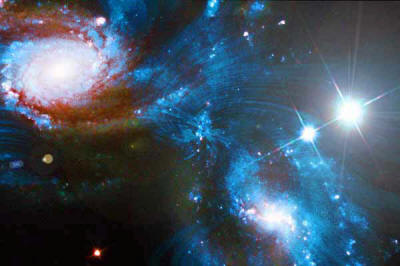|

by Natalie Wolchover
Life's Little Mysteries Staff Writer
18 March 201
from
LifesLittleMysteries Website

Considering the amount of energy packed in the nucleus of a single
uranium atom, or the energy that has been continuously radiating
from the sun for billions of years, or the fact that there are 1080
particles in the observable universe, it seems that the total energy
in the universe must be an inconceivably vast quantity.
But it's
not; it's probably zero.
Light, matter and antimatter are what physicists call "positive
energy." And yes, there's a lot of it (though no one is sure quite
how much).
Most physicists think, however, that there is an equal
amount of "negative energy" stored in the gravitational attraction
that exists between all the positive-energy particles.
The positive
exactly balances the negative, so, ultimately, there is no energy in
the universe at all.
Negative energy?
Stephen Hawking explains the concept of negative energy in his book
The Theory of Everything (2002):
"Two pieces of
matter that are close to each other have less [positive] energy than
the same two pieces a long way apart, because you have to expend
energy to separate them against the gravitational force that is
pulling them together," he wrote.
Since it takes positive energy to separate the two pieces of matter,
gravity must be using negative energy to pull them together.
Thus,
"the gravitational field has negative energy. In the case of a
universe that is approximately uniform in space, one can show that
this negative gravitational energy exactly cancels the positive
energy represented by the matter. So the total energy of the
universe is zero."
Astrophysicists Alexei Filippenko at the University of California,
Berkeley and Jay Pasachoff at Williams College explain gravity's
negative energy by way of example in their essay, "A Universe From
Nothing":
"If you drop a ball from rest (defined to be a state of
zero energy), it gains energy of motion (kinetic energy) as it
falls. But this gain is exactly balanced by a larger negative
gravitational energy as it comes closer to Earth’s center, so the
sum of the two energies remains zero."
In other words, the ball's positive energy increases, but at the
same time, negative energy is added to the Earth's gravitational
field.
What was a zero-energy ball at rest in space later becomes a
zero-energy ball that is falling through space.
The universe as a whole can be compared to this ball. Initially,
before the big bang, the universe-ball was at rest. Now, after the
big bang, it is falling: light and matter exist, and they are
moving.
And yet, because of the negative energy built into the
gravity field created by these particles, the total energy of the
universe remains zero.
Ultimate free lunch
The question, then, is why the ball started falling in the first
place. How did something - composed of equal positive and negative
parts, mind you - come from nothing?
Physicists aren't exactly sure, but their best guess is that the
extreme positive and negative quantities of energy randomly
fluctuated into existence.
"Quantum theory, and specifically
Heisenberg’s uncertainty principle, provide a natural explanation
for how that energy may have come out of nothing," wrote Filippenko
and Pasachoff.
They continued,
"Throughout the universe, particles and
antiparticles spontaneously form and quickly annihilate each other
without violating the law of energy conservation.
These spontaneous
births and deaths of so-called 'virtual particle' pairs are known as
'quantum fluctuations.' Indeed, laboratory experiments have proven
that quantum fluctuations occur everywhere, all the time."
Cosmologists have constructed a
theory called inflation that
accounts for the way in which a small volume of space occupied by a
virtual particle pair could have ballooned to become the vast
universe we see today.
Alan Guth, one of the main brains behind
inflationary cosmology, thus described the universe as "the ultimate
free lunch."
In a lecture, Caltech cosmologist Sean Carroll put it this way:
"You
can create a compact, self-contained universe without needing any
energy at all."
|

